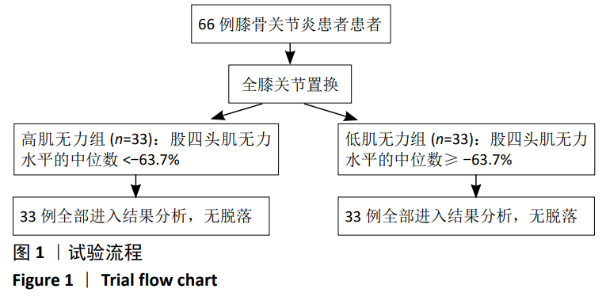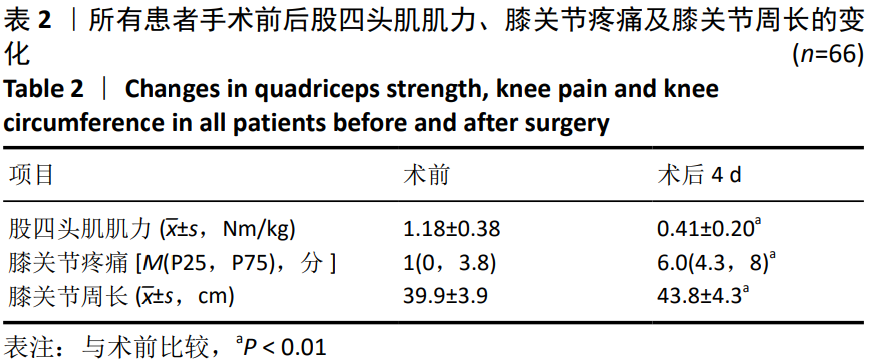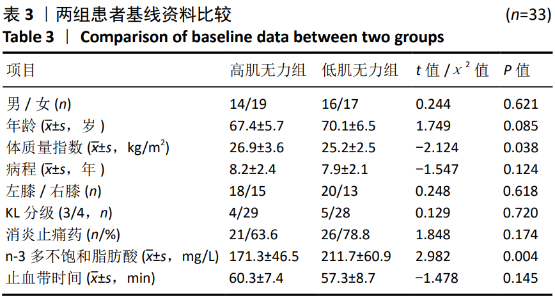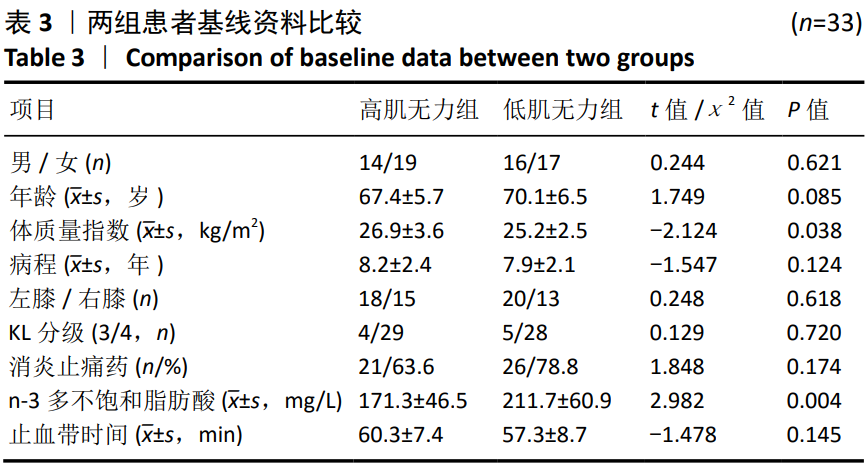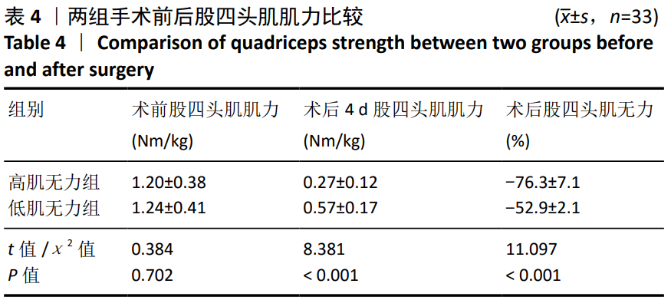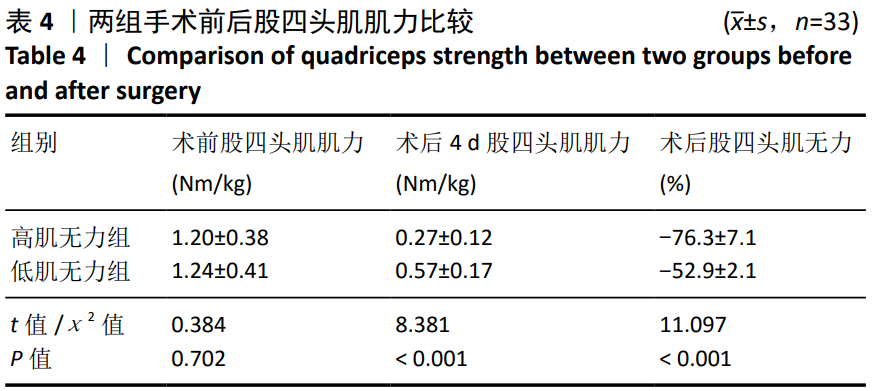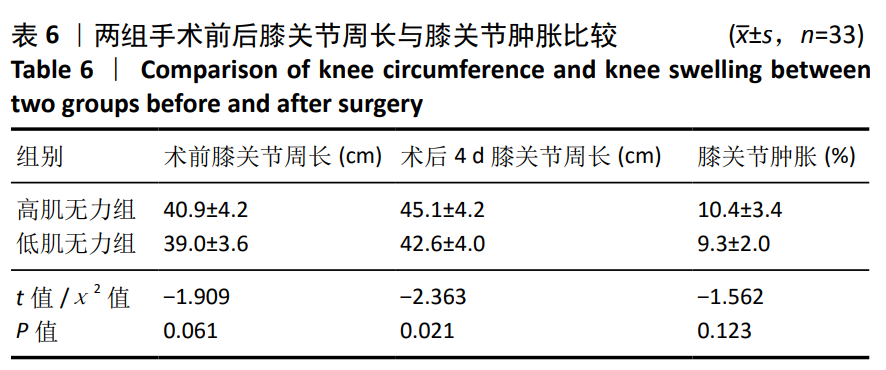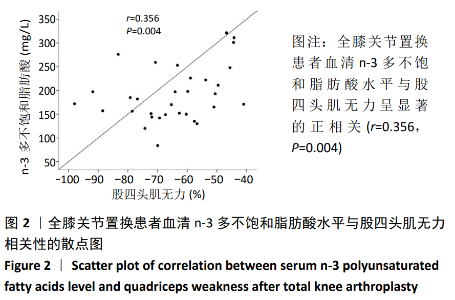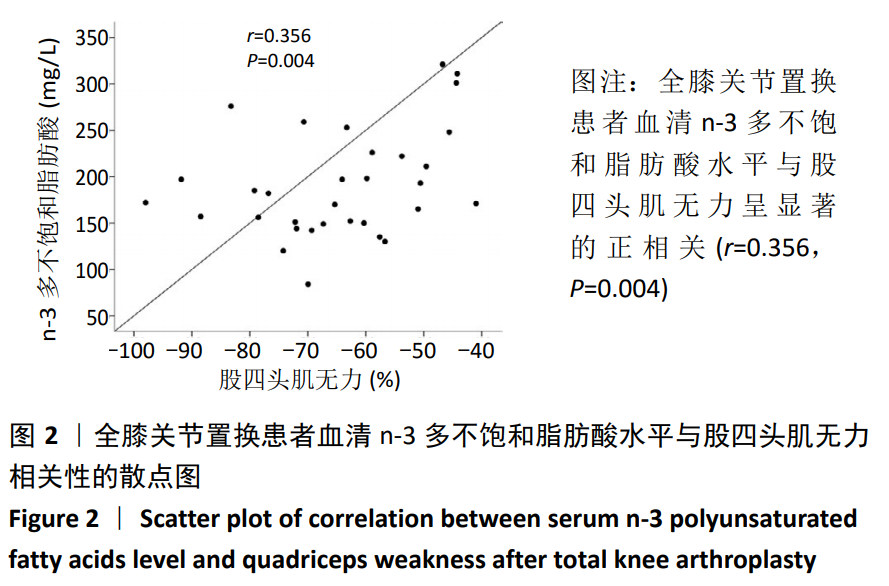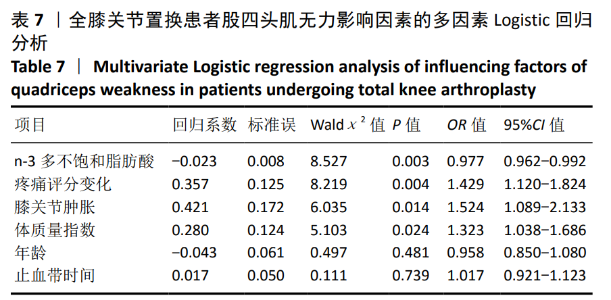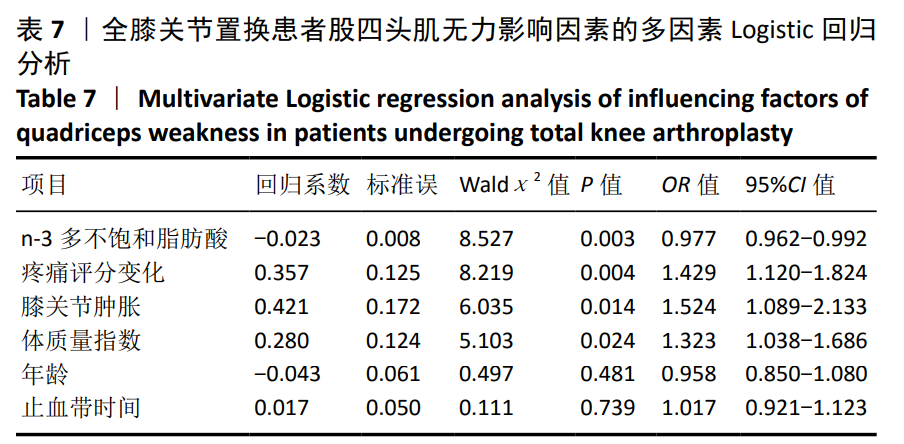Chinese Journal of Tissue Engineering Research ›› 2021, Vol. 25 ›› Issue (9): 1375-1380.doi: 10.3969/j.issn.2095-4344.3763
Previous Articles Next Articles
Correlation between the level of serum n-3 polyunsaturated fatty acids and quadriceps weakness in the early stage after total knee arthroplasty
Huang Zexiao, Yang Mei, Lin Shiwei, He Heyu
- Department of Emergency, Second Affiliated Hospital of Hainan Medical University, Haikou 570203, Hainan Province, China
-
Received:2020-05-09Revised:2020-05-14Accepted:2020-06-09Online:2021-03-28Published:2020-12-15 -
Contact:He Heyu, Associate chief physician, Department of Emergency, Second Affiliated Hospital of Hainan Medical University, Haikou 570203, Hainan Province, China -
About author:Huang Zexiao, Attending physician, Department of Emergency, Second Affiliated Hospital of Hainan Medical University, Haikou 570203, Hainan Province, China -
Supported by:the Key Research and Development Project of Social Development in Hainan Province, No. ZDYF2019146
CLC Number:
Cite this article
Huang Zexiao, Yang Mei, Lin Shiwei, He Heyu. Correlation between the level of serum n-3 polyunsaturated fatty acids and quadriceps weakness in the early stage after total knee arthroplasty[J]. Chinese Journal of Tissue Engineering Research, 2021, 25(9): 1375-1380.
share this article
| [1] 郭子荷,王春婷,陆巍.全膝关节置换术患者肌力康复护理的证据综合[J].护理学杂志,2019,34(21):7-10. [2] 周萌,林川,贾晶丽, 等.膝关节置换术后患者出院随访的最佳证据总结[J].中华护理杂志,2019,54(12):1877-1880. [3] LEON-MUNOZ VJ, LISON-ALMAGRO AJ, HERNANDEZ-GARCIA CH, et al. Silicone ring tourniquet versus pneumatic cuff tourniquet in total knee arthroplasty surgery: A randomised comparative study. J Orthop. 2018; 15(2):545-548. [4] HASANAIN MS, APOSTU D, ALREFAEE A, et al. Comparing the Effect of Tourniquet vs Tourniquet-Less in Simultaneous Bilateral Total Knee Arthroplasties. J Arthroplasty. 2018;33(7):2119-2124. [5] 凌坤,宋超,石秀霞.膝关节置换术后下肢深静脉血栓危险因素研究[J].中华实验外科杂志,2019,36(5):843. [6] DENNIS DA, KITTELSON AJ, YANG CC, et al. Does T ourniquet Use in TKA Affect Recovery of Lower Extremity Strength and Function? A Randomized Trial. Clin Orthop Relat Res. 2016;474(1):69-77. [7] PIUZZI NS, STRNAD GJ, SAKR ESA WA, et al. The Main Predictors of Length of Stay After Total Knee Arthroplasty:Patient-Related or Procedure-Related Risk Factors.J Bone Joint Surg Am.2019;101(12): 1093-1101. [8] 罗盛飞,曲由,陈建,等.髌骨肌贴对股四头肌肌力及膝关节疼痛的影响[J].中国组织工程研究,2014,18(25):4078-4083. [9] PUA YH. The Time Course of Knee Swelling Post Total Knee Arthroplasty and Its Associations with Quadriceps Strength and Gait Speed.J Arthroplasty. 2015;30(7):1215-1219. [10] WANG K, NI S, LI Z, et al. The effects of tourniquet use in total knee arthroplasty: a randomized, controlled trial.Knee Surg Sports Traumatol Arthrosc.2017;25(9):2849-2857. [11] DREYER HC. Tourniquet Use During Knee Replacement Surgery May Contribute to Muscle Atrophy in Older Adults.Exerc Sport Sci Rev. 2016; 44(2):61-70. [12] GULER O, MAHIROGULLARI M, ISYAR M, et al. Comparison of quadriceps muscle volume after unilateral total knee arthroplasty with and without tourniquet use. Knee Surg Sports Traumatol Arthrosc. 2016;24(8):2595-605. [13] BU J, DOU Y, TIAN X, et al. The Role of Omega-3 Polyunsaturated Fatty Acids in Stroke. Oxid Med Cell Longev. 2016;1(1):6906712. [14] WANG B, WU XW, GUO MX, et al. Effects of omega-3 fatty acids on toll-like receptor 4 and nuclear factor-kappaB p56 in lungs of rats with severe acute pancreatitis.World J Gastroenterol.2016;22(44): 9784-9793. [15] 中华医学会骨科学分会关节外科学组.骨关节炎诊疗指南(2018年版)[J].中华骨科杂志,2018,38(12):705-715. [16] PUA YH, POON CL, SEAH FJ, et al. Comparative performance of isometric and isotonic quadriceps strength testing in total knee arthroplasty. Musculoskelet Sci Pract.2018;37(1):17-19. [17] SI HB, YANG TM, ZENG Y, et al. Correlations between inflammatory cytokines,muscle damage markers and acute postoperative pain following primary total knee arthroplasty.Bmc Musculoskeletal Disorders. 2017;18(1):1-9. [18] PARAVLIC AH, KOVAC S, PISOT R, et al. Neurostructural correlates of strength decrease following total knee arthroplasty:A systematic review of the literature with meta-analysis.Bosn J Basic Med Sci.2020;20(1): 1-12. [19] CHRISTENSEN JC, MIZNER RL, BO FOREMAN K, et al. Preoperative quadriceps weakness preferentially predicts postoperative aberrant movement patterns during high-demand mobility following total knee arthroplasty.Knee.2019;26(1):79-87. [20] 赵俊涛,郑成胜,王博.全膝关节置换中止血带的优化应用方案[J].中国组织工程研究,2019,23(20):3124-3129. [21] LOYD BJ, STACKHOUSE SK, HOGAN C, et al. Peripheral Nociception Is Associated with Voluntary Activation Deficits and Quadriceps Weakness Following Total Knee Arthroplasty.J Bone Joint Surg Am. 2019;101(17): 1539-1545. [22] ILFELD BM, BALL ST, GABRIEL RA, et al. A Feasibility Study of Percutaneous Peripheral Nerve Stimulation for the Treatment of Postoperative Pain Following Total Knee Arthroplasty.Neuromodulation. 2019;22(5):653-660. [23] LAUBACH M, HELLMANN JT, DIRRICHS T, et al. Anterior knee pain after total knee arthroplasty:A multifactorial analysis.J Orthop Surg (Hong Kong). 2020;28(2):2309499020918947. [24] KILGAS MA, DENHERDER AE, LYTLE LLM, et al. Home-Based Exercise With Blood Flow Restriction to Improve Quadriceps Muscle and Physical Function After Total Knee Arthroplasty:A Case Report.Phys Ther. 2019;99(11):1495-1500. [25] SVAHN SL, GUTIERREZ S, ULLERYD MA, et al. Dietary Polyunsaturated Fatty Acids Promote Neutrophil Accumulation in the Spleen by Altering Chemotaxis and Delaying Cell Death.Infect Immun. 2019;87(8):1-9. [26] BIRD JK, CALDER PC, EGGERSDORFER M. The Role of n-3 Long Chain Polyunsaturated Fatty Acids in Cardiovascular Disease Prevention, and Interactions with Statins. Nutrients. 2018;10(6):1-6. [27] 李程,张坚.n-3多不饱和脂肪酸对老年人认知障碍影响的研究进展[J].中国慢性病预防与控制,2019,27(12):943-947. [28] 张珊,李红,董矜, 等.老年人多不饱和脂肪酸水平与血脂血糖的相关性分析[J].中华保健医学杂志,2016,18(1):27-30. [29] BROWN MJC, VELLA-BALDACCHINO M, O’FLAHERTY E, et al. Predicting patient reported outcome in total knee arthroplasty using body mass index and limb measurements.Knee. 2018;25(5):915-922. [30] LOYD BJ, STACKHOUSE S, DAYTON M, et al. The relationship between lower extremity swelling,quadriceps strength,and functional performance following total knee arthroplasty.Knee.2019;26(2): 382-391. [31] 曹青刚,包倪荣.止血带导致全膝关节置换术后肢体肿痛机制的研究[J].医学研究生学报,2019,32(4):428-431. |
| [1] | Hu Kai, Qiao Xiaohong, Zhang Yonghong, Wang Dong, Qin Sihe. Treatment of displaced intra-articular calcaneal fractures with cannulated screws and plates: a meta-analysis of 15 randomized controlled trials [J]. Chinese Journal of Tissue Engineering Research, 2021, 25(9): 1465-1470. |
| [2] | Huang Dengcheng, Wang Zhike, Cao Xuewei. Comparison of the short-term efficacy of extracorporeal shock wave therapy for middle-aged and elderly knee osteoarthritis: a meta-analysis [J]. Chinese Journal of Tissue Engineering Research, 2021, 25(9): 1471-1476. |
| [3] | Xu Feng, Kang Hui, Wei Tanjun, Xi Jintao. Biomechanical analysis of different fixation methods of pedicle screws for thoracolumbar fracture [J]. Chinese Journal of Tissue Engineering Research, 2021, 25(9): 1313-1317. |
| [4] | Jiang Yong, Luo Yi, Ding Yongli, Zhou Yong, Min Li, Tang Fan, Zhang Wenli, Duan Hong, Tu Chongqi. Von Mises stress on the influence of pelvic stability by precise sacral resection and clinical validation [J]. Chinese Journal of Tissue Engineering Research, 2021, 25(9): 1318-1323. |
| [5] | Zhang Tongtong, Wang Zhonghua, Wen Jie, Song Yuxin, Liu Lin. Application of three-dimensional printing model in surgical resection and reconstruction of cervical tumor [J]. Chinese Journal of Tissue Engineering Research, 2021, 25(9): 1335-1339. |
| [6] | Zhang Yu, Tian Shaoqi, Zeng Guobo, Hu Chuan. Risk factors for myocardial infarction following primary total joint arthroplasty [J]. Chinese Journal of Tissue Engineering Research, 2021, 25(9): 1340-1345. |
| [7] | Li Dadi, Zhu Liang, Zheng Li, Zhao Fengchao. Correlation of total knee arthroplasty efficacy with satisfaction and personality characteristics [J]. Chinese Journal of Tissue Engineering Research, 2021, 25(9): 1346-1350. |
| [8] | Wei Wei, Li Jian, Huang Linhai, Lan Mindong, Lu Xianwei, Huang Shaodong. Factors affecting fall fear in the first movement of elderly patients after total knee or hip arthroplasty [J]. Chinese Journal of Tissue Engineering Research, 2021, 25(9): 1351-1355. |
| [9] | Wang Jinjun, Deng Zengfa, Liu Kang, He Zhiyong, Yu Xinping, Liang Jianji, Li Chen, Guo Zhouyang. Hemostatic effect and safety of intravenous drip of tranexamic acid combined with topical application of cocktail containing tranexamic acid in total knee arthroplasty [J]. Chinese Journal of Tissue Engineering Research, 2021, 25(9): 1356-1361. |
| [10] | Xiao Guoqing, Liu Xuanze, Yan Yuhao, Zhong Xihong. Influencing factors of knee flexion limitation after total knee arthroplasty with posterior stabilized prostheses [J]. Chinese Journal of Tissue Engineering Research, 2021, 25(9): 1362-1367. |
| [11] | Peng Zhihao, Feng Zongquan, Zou Yonggen, Niu Guoqing, Wu Feng. Relationship of lower limb force line and the progression of lateral compartment arthritis after unicompartmental knee arthroplasty with mobile bearing [J]. Chinese Journal of Tissue Engineering Research, 2021, 25(9): 1368-1374. |
| [12] | Zhang Chong, Liu Zhiang, Yao Shuaihui, Gao Junsheng, Jiang Yan, Zhang Lu. Safety and effectiveness of topical application of tranexamic acid to reduce drainage of elderly femoral neck fractures after total hip arthroplasty [J]. Chinese Journal of Tissue Engineering Research, 2021, 25(9): 1381-1386. |
| [13] | Wang Haiying, Lü Bing, Li Hui, Wang Shunyi. Posterior lumbar interbody fusion for degenerative lumbar spondylolisthesis: prediction of functional prognosis of patients based on spinopelvic parameters [J]. Chinese Journal of Tissue Engineering Research, 2021, 25(9): 1393-1397. |
| [14] | Lü Zhen, Bai Jinzhu. A prospective study on the application of staged lumbar motion chain rehabilitation based on McKenzie’s technique after lumbar percutaneous transforaminal endoscopic discectomy [J]. Chinese Journal of Tissue Engineering Research, 2021, 25(9): 1398-1403. |
| [15] | Chen Xinmin, Li Wenbiao, Xiong Kaikai, Xiong Xiaoyan, Zheng Liqin, Li Musheng, Zheng Yongze, Lin Ziling. Type A3.3 femoral intertrochanteric fracture with augmented proximal femoral nail anti-rotation in the elderly: finite element analysis of the optimal amount of bone cement [J]. Chinese Journal of Tissue Engineering Research, 2021, 25(9): 1404-1409. |
| Viewed | ||||||
|
Full text |
|
|||||
|
Abstract |
|
|||||
